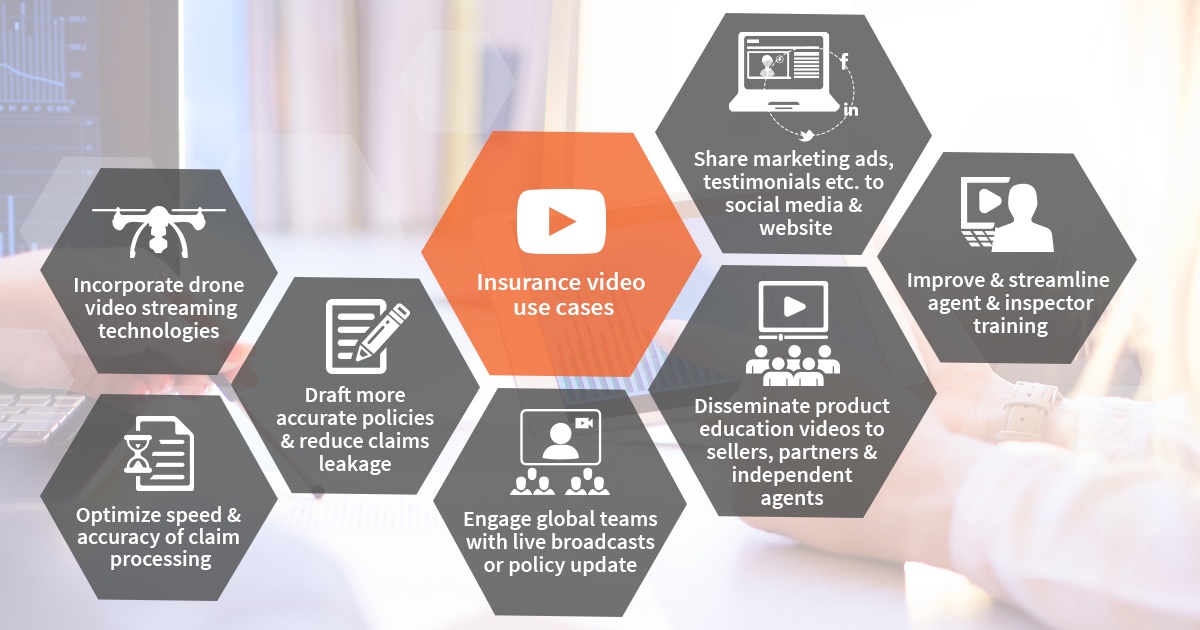Using Video to Reduce Insurance Claims for Health Insurers
by VIDIZMO Team on August 11,2020

In 2016, a research carried out by the Milken Institute found that chronic diseases accounted for about 5.8% of the U.S. GDP in healthcare. The indirect costs in the form of lost productivity were even greater; an estimated 19.6% of the GDP. More importantly, chronic diseases are on the rise and these costs will be even greater in the future.
This rise of chronic diseases has had a direct impact on the costs of health insurance companies. Ernst and Young mentioned that chronic diseases would be one of the major challenges for health insurers in the future. As more people suffer from these diseases, insurance companies find themselves with an increasing number of costly claims being made for such diseases. But what can health insurers do to tackle this challenge? Should they remain passive as chronic diseases rise? Or should they actively manage them?
The future of healthcare is about being preventative rather than just being reactive. This means that health insurers and healthcare providers need to push for behavioral change among the general public to reduce the likelihood of these diseases occurring in the first place. People suffering from chronic diseases need to be provided with care at an early stage to reduce the likelihood of them becoming more serious later on. This would help people lead healthier lives while saving costs in the long run for healthcare providers and insurers.
The Role of Health Insurance Companies
Health insurance companies need to move from just being health insurers to become "healthcare liaisons". This means that health insurance companies need to be more active in facilitating delivery of healthcare services. They need to develop partnerships with healthcare providers and provide services to improve the overall health of their customers. This is important for chronic diseases as the overall costs of care can be reduced if these diseases are managed early on. Health insurers can also use these additional services as a differentiating factor between them and their competitors.
One of the challenges for health insurers that prevents them from doing so is that they have a large number of customers that are geographically dispersed. This makes it difficult for health insurers to provide health services to each and every customer in a cost-effective manner. However, innovations in digital technology help tackle this challenge. For example, instead of one-on-one visits to a doctor to address patient queries regarding a chronic disease, health insurers can now use technology to connect customers and doctors through a video call. A single doctor can also address multiple customers at a time using live video streaming.
Overall, innovations in digital technology have enabled health insurers to reimagine healthcare. The improved operational efficiency provided by digital technologies enables health insurers to be more actively involved in healthcare, which was not possible before due to high costs. Health insurance companies can now partner with healthcare providers and facilitate delivery of healthcare services. This will help people live healthier while saving costs in the long run for healthcare providers and insurers.
Providing Healthcare Services Through Video Content
One way in which Health insurance companies can leverage digital technologies is through distribution of video content. Video content is an effective solution for health insurance companies to provide health services to their customers. Here are a few reasons why:
- It Increases Operational Efficiency: Video allows for communication to take place with a large number of people using fewer resources. A doctor only needs to record a video once and it can be viewed multiple times by thousands of people with the same condition.
- It Triggers Behavioral Change: Video content can be used to inform non-sufferers about risk factors related to chronic diseases. These videos can persuade non-sufferers to change their daily habits and adopt a healthier lifestyle.
- It Provides Information to Manage Chronic Diseases: These videos can also be used to provide sufferers with information to better manage and delay the progression of their disease.
- It Induces Engagement: Video content is more likely to engage customers as compared to information in textual form as people are reluctant to read large amounts of text.
- It Caters to Underserved Citizens: Video can be used to provide guidance to people that are currently underserved by the healthcare system.
Here are a few different ways in which health insurance companies can use video to reimagine healthcare and engage with their customers:
- Live Streaming: Healthcare professionals can conduct webinars to address a large audience on issues surrounding chronic diseases.
- One-to-One Consultation through Videoconferencing: Patients can connect to doctors online through videoconferencing. These are known as telehealth services and you can click here to read an article covering this in more detail.
- On Demand Video: Video has the ability to be distributed to a large audience and can be watched multiple times as long as one has access to it.
Using VIDIZMO Enterprise Video Platform to Provide Healthcare Services
VIDIZMO Enterprise Video Platform allows Health Insurers to utilize the benefits of video technology. Health insurers can use YouTube to provide their customers with healthcare services as well. However, here are a few features that VIDIZMO offers and YouTube does not:
- Automatic ingestion and uploading of videoconferencing recordings from Microsoft Teams, Zoom, Skype, WebEx, Go-to-Meeting, etc.
- Integration with other business application such as Microsoft Office 365.
- Live streaming videos of healthcare professionals for a large audience, which can be recorded and viewed later as well.
- Segregation of content based on groups, where for example, customers suffering from heart disease are only shown content regarding heart disease. This helps make every treatment plan more personal.
- Artificial intelligence to analyze patient videos and gain valuable insights regarding various diseases. Azure Cognitive Services used by VIDIZMO can help analyze videos to find out about common symptoms amongst patients with similar medical conditions.
- Interactive learning elements like quizzes and surveys within videos to increase user engagement and participation to promote active engagement instead of passive viewing.
- Detailed platform analytics to track user-level engagement, overall viewing trends, video completion rates/drop-off rates, quality of viewing metrics etc.
- Automatic video transcription and close captions for all videos using artificially intelligent speech recognition technology by Azure Cognitive Services. This helps cater to audiences with hearing difficulties.
- Transcription of videos in a range of internationally spoken languages.
- Unique and powerful search capabilities that allow users to search inside video content for any spoken words or onscreen text that appears during a video.
- Flexible storage options where video content can be stored on-premise, Azure Cloud, AWS Cloud, any other cloud provider of choice, or a hybrid model that combines on-premise and cloud infrastructure.
- Leading public and enterprise content delivery networks (CDN) such as Microsoft Azure CDN so people can access content from any location.
To conclude, health insurance companies need to integrate with healthcare providers and leverage digital technology to serve as a liaison facilitating their customers in use of healthcare services. VIDIZMO facilitates health insurance companies in doing so by providing a video platform to health insurers where they can share healthcare videos with their customers. This would help them reach out to their customers in a cost-effective manner.
Through video, customers can then learn more about their disease, change their lifestyle, and connect with healthcare providers to receive treatment early in their disease. This would help health insurers achieve the eventual goal of helping their customers live more healthier lives, saving cost for healthcare providers and themselves in the long run.
To learn how you can use VIDIZMO for health insurance
Jump to
You May Also Like
These Related Stories

Why Insurance Knowledge Management Is the Need of Hour?

7 streaming video use cases in the insurance industry


No Comments Yet
Let us know what you think